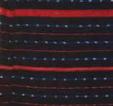Basic HTML Version



สาขางานช่
างฝี
มื
อดั้
งเดิ
ม
มรดกภู
มิ
ปั
ญญาทางวั
ฒนธรรม
50
Mat Mi Cloth
Mat Mi cloth
(Ikat) is a kind of fabric woven from
the tie-dyed yarns to create motif designs. It is a
traditional art of weaving that has been practiced
since ancient time -- particularly in the northeastern
region of Thailand; in some provinces in the central
region such as Chainat, Uthai Thani, Suphanburi,
Kanchanaburi, and Lopburi provinces; and in the
northern region in Chiang Mai and Nan Provinces, for
example.
To create the motif, the cotton or silk yarns
are combed and selected for adequate yarns to
meet the requirement of the design. The yarns are
then stretched on a frame called Hong Mi, and tied
at specific positions to block the dye. In the past,
banana-stem strings were used for tying, today
polypropylene film packag ing rope i s used.
The yarns are then soaked in dye and dried in the sun.
The s t r i ngs are then unt i ed, revea l i ng the
unaffected part. The process can be repeated several
times as required - with the yarns being tied
at different points and by using different dye color.
Experience and craftsmanship skill are necessary
for finding the precise and correct posi t ions
to tie the strings on the yarns so as to create
the desi red moti f or pattern because, unl ike
the Ikat weavers of other countries, the Thai weavers
of Mat Mi cloth do not mark the exact spots or positions
beforehand, but remember the correct positions by
rote and through experience.
During the weaving
stage, the weavers must
make sure they use
the spools of tie-dyed
yarns in the correct
sequence from one
spoo l t o ano t he r .
They must also be
able to adjust the
ove r l app i ng mo t i f
a n d c o r r e c t t h e
mi s takes f rom the
dying stage.
An intellectual heritage in the craftsmanship
domain, Mat Mi making requires great technical skill
and know-how.
The Mat Mi motifs that are handed down
from generation to generation since ancient time
were mostly inspired by nature, the surroundings,
the beliefs, and tradition -- for example, the Orange-
Jasmine motif, the Pine motif, the Five-Lantern
motif, the Seven-Lantern motif, the Bai Si motif,
the Deer motif, the Peacock motif, the Turtle motif,
and the Naga motif.
Mat Mi plays a role in the way of life of people
from birth to death. Young women have to weave
to make fabric for clothing. The cotton and silk yarns
indicate the potential for trade and commerce, because
they were used for trade in the past. The natural dyes
reflect the rich variety of plants in Thailand, which yields
the unique palette of colors in the Thai Mat Mi fabric,
as well as the skill of each group of people in the use
of natural dyes.
Today, the know-how on Mat Mi cloth making is
still being transmitted, to a certain degree, from one
generation to another in the rural areas of Thailand.
However, the number of the younger generations
who are interested in learning and continuing the
art and craft of Mat Mi cloth making has dwindled
and several communities are unable to perpetuate
this intellectual heritage. It is important that agencies
concerned should take part in preserving and
perpetuating this valuable cultural legacy.

